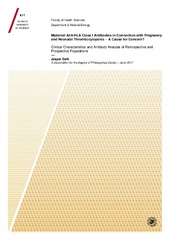Maternal Anti-HLA Class I Antibodies in Connection with Pregnancy and Neonatal Thrombocytopenia – a Cause for Concern? Clinical Characteristics and Antibody Analysis of Retrospective and Prospective Populations
Permanent lenke
https://hdl.handle.net/10037/11495Åpne
Thesis (PDF)
Paper I: Dahl, J., Husebekk, A., Acharya, G., Flo, K., Stuge, T. B., Skogen, B., Straume, B., Tiller, H.: “Maternal anti-HLA class I antibodies are associated with reduced birth weight in thrombocytopenic neonates”. Also available in J Reprod Immunol. 2016, 113:27-34. (PDF)
Dato
2017-09-08Type
Doctoral thesisDoktorgradsavhandling
Forfatter
Dahl, JesperSammendrag
Background: Fetal and neonatal alloimmune thrombocytopenia (FNAIT) is caused by maternal antibodies that target fetal platelets during pregnancy. It can occur when fetal platelets express a paternally-inherited antigen that is not shared by the mother. Maternal antibodies that cause FNAIT are directed against human platelet antigens (HPAs) on fetal platelets, and the resulting fetal/ neonatal thrombocytopenia can range from non-symptomatic to life-threatening. The polymorphic human leukocyte antigens (HLA) class I are also expressed on platelets. It has long been hypothesized that anti-HLA class I antibodies could be a cause of FNAIT, since they are a well-known cause of platelet refractoriness following transfusion, and often appear in cases with suspected FNAIT, both alone and alongside anti-HPA antibodies. Anti-HLA class I antibodies are also a frequent occurrence in uncomplicated pregnancies, and have not been definitively tied to any adverse fetal-maternal outcome, although multiple associations have been reported.
Results: Using retrospective data from the Norwegian National Unit for Platelet Immunology in Tromsø and data from a previous large prospective screening study on FNAIT, we have described the antibody properties and clinical characteristics of cases with suspected FNAIT due to anti-HLA class I antibodies alone, as well as alongside anti-HPA antibodies, and compared these to data from control pregnancies. We found that newborns with suspected FNAIT due to maternal anti-HLA class I antibodies typically had severe thrombocytopenia, and a frequency of intracranial hemorrhage comparable to what is reported for anti-HPA antibody induced FNAIT.
A surprisingly high number of these children were first-borns, and many of the children were also small for gestational age (SGA). An increasing anti-HLA class I antibody level was found to be associated with a decreasing birth weight. Maternal immunization was not tied to any particular HLA class I antigen, but the detected maternal anti-HLA class I antibodies were specific towards paternally-inherited fetal epitopes. Anti-HLA class I antibody levels were higher in cases with suspected FNAIT compared to control pregnancies with detectable anti-HLA class I antibodies. When detected together with anti-HPA-1a antibodies, the presence of anti-HLA class I antibodies was associated with an increased risk of neonatal thrombocytopenia as well as more severe thrombocytopenia, particularly in pregnancies where the mother was nulliparous.
Conclusions: We found that neonates with suspected FNAIT due to maternal anti-HLA class I antibodies not only had severe thrombocytopenia, but that the combination of anti-HLA class I antibodies with neonatal thrombocytopenia was associated with significant perinatal morbidity. Furthermore, we have demonstrated that the additional presence of anti-HLA class I antibodies in HPA-1a alloimmunized pregnancies was associated with an increased risk and severity of neonatal thrombocytopenia. These findings were particularly evident for first-borns. However, since our studies could not address the central question of causality, it remains unclear whether or not the presence of anti-HLA class I antibodies are an epiphenomenon in pregnancies where the neonate develops thrombocytopenia. This question would need to be addressed in a larger prospective study.
Beskrivelse
The papers 2 and 3 of this thesis are not available in Munin.
Paper II: Dahl, J., Refsum, E., Ahlen, M. T., Egeland, T., Jensen, T., Viken, M. K., Stuge, T. B., Acharya, G., Husebekk, A., Skogen, B., Tiller, H.: “Unraveling the Role of Maternal Anti-HLA Class I Antibodies in Fetal and Neonatal Thrombocytopenia – Antibody Specificity Analysis Using Epitope Data”. (Manuscript). Published version available in J Reprod Immunol. 2017, 122:1-9.
Paper III: Dahl, J., Skogen, B. Kjaer, M., Husebekk, A., Kjeldsen-Kragh, J., Tiller, H.: “Maternal anti-HLA class I antibodies in addition to anti-HPA-1a antibodies influence severity of fetal and neonatal alloimmune thrombocytopenia (FNAIT) – data from a large prospective screening study”. (Manuscript).
Paper II: Dahl, J., Refsum, E., Ahlen, M. T., Egeland, T., Jensen, T., Viken, M. K., Stuge, T. B., Acharya, G., Husebekk, A., Skogen, B., Tiller, H.: “Unraveling the Role of Maternal Anti-HLA Class I Antibodies in Fetal and Neonatal Thrombocytopenia – Antibody Specificity Analysis Using Epitope Data”. (Manuscript). Published version available in J Reprod Immunol. 2017, 122:1-9.
Paper III: Dahl, J., Skogen, B. Kjaer, M., Husebekk, A., Kjeldsen-Kragh, J., Tiller, H.: “Maternal anti-HLA class I antibodies in addition to anti-HPA-1a antibodies influence severity of fetal and neonatal alloimmune thrombocytopenia (FNAIT) – data from a large prospective screening study”. (Manuscript).
Forlag
UiT The Arctic University of NorwayUiT Norges arktiske universitet
Metadata
Vis full innførselSamlinger
Copyright 2017 The Author(s)
Følgende lisensfil er knyttet til denne innførselen:


 English
English norsk
norsk
